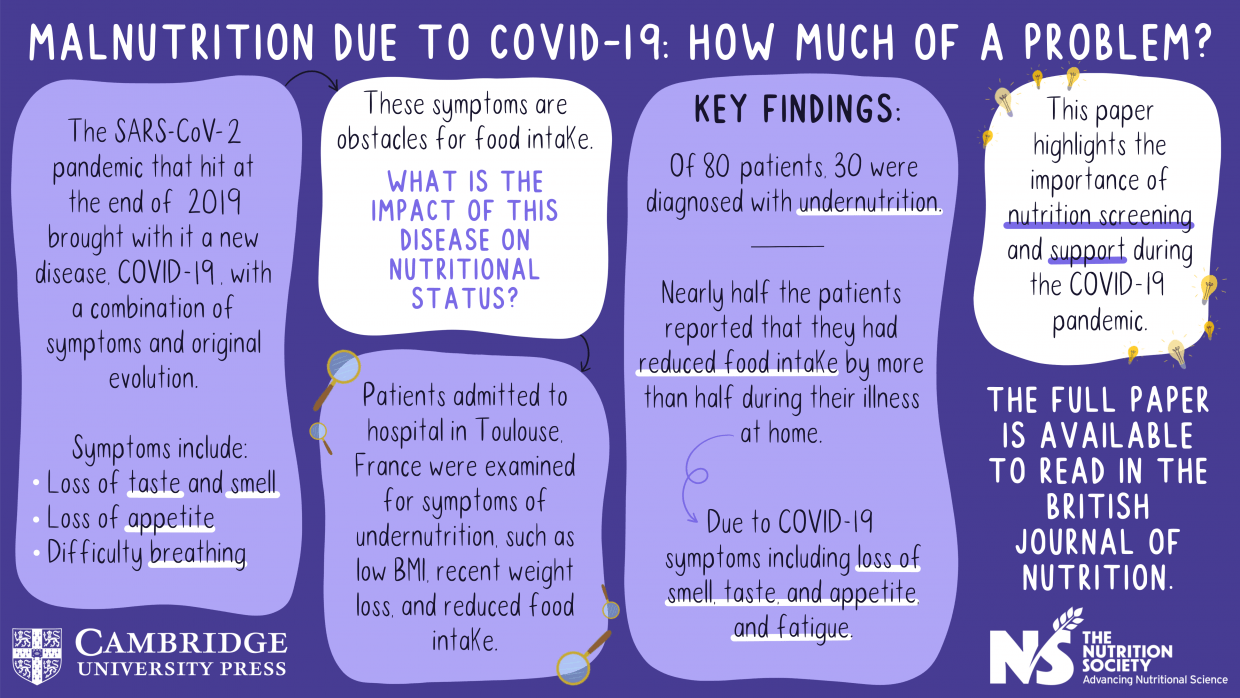Malnutrition due to COVID-19, How big of a problem?
The Paper of the Month for January 2021 is ‘Prevalence Of Malnutrition In Covid-19 Inpatients: The Nutricov Study’ from the British Journal of Nutrition and is free to access for 1 month.
The SARS-CoV2 pandemic that hit the planet at the end of 2019 brings a new disease with a combination of symptoms and an original evolution. Patients report symptoms such as loss of taste or smell, loss of appetite, difficulty in breathing …
Thus, we looked for undernutrition in all of our patients admitted to hospital for COVID19. For this purpose, we used the clinical diagnosis method proposed by GLIM (Global Leadership Initiative on Malnutrition), an international expert group. This included low BMI, recent weight loss, reduced food intake and acute illness (here, COVID19!).
In 80 patients hospitalized successively for COVID-19, we found that 30 of them had a diagnosis of undernutrition. This diagnosis was made on the day of arrival at the hospital after an average of 7 days of symptom progression at home.
Many these symptoms are potential obstacles to food intake. This led, naturally, to the question of the impact of this disease on nutritional status.
Among these 80 hospitalized patients, 46% declared that they had reduced their food intake by more than half during their illness at home. They reported this in more than a quarter of cases due to loss of taste (28) or loss of appetite (28%), and in one in five cases to fatigue or loss of smell. At admission, their blood concentrations of albumin was low as is found in other severe inflammatory diseases.
We did not find any relationship between reduced oral intake at home and the diagnosis of undernutrition on the day of hospital admission. This relationship may have been masked by the small size of our population or by another cause of malnutrition as inflammatory origin.
Among the patients in our study, those who were malnourished patients were not admitted to the intensive care unit more often than the better nourished patients. The 3 patients who died were malnourished, but the causes of their deaths was unlikely to be due directly to their malnutrition.
We also studied the cross-sectional area of the pectoral muscle measured on the chest CT scans of all our patients. This has been proposed as a prognostic index related to the musculature of patients with certain diseases. We did not find any difference in this measurement between our malnourished and well-nourished patients.
The high prevalence of undernutrition in COVID-19 patients illustrates the importance of nutrition screening during the pandemic and the need for adapted and optimized nutritional care to support recovery from the disease.

Each month a paper is selected by one of the Editors of the five Nutrition Society Publications (British Journal of Nutrition, Public Health Nutrition, Nutrition Research Reviews, Proceedings of the Nutrition Society and Journal of Nutritional Science). Take a look at the entire Nutrition Society Paper of the Month Collection.




